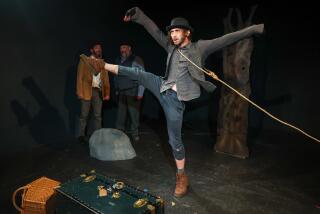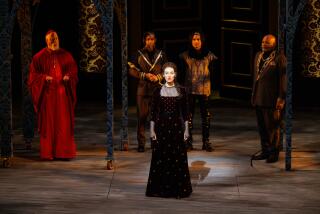Magic breaks the spell of ‘The Tempest’ in Vegas
LAS VEGAS — Telling friends that you’re heading to Las Vegas for some Shakespeare is a bit like claiming you read Playboy for the interviews.
Well, I did indeed head to Vegas last weekend to see “The Tempest,” and I can guarantee that I was the only person on my morning flight reading Harold C. Goddard’s classic “The Meaning of Shakespeare.” Just a few pages from the chapter on “The Tempest,” mind you. The guys downing pre-lunch wine and cocktails around me were whooping it up “Hangover”-style.
I swore off Vegas a few years ago. I’m not much of a gambler, condensed versions of Broadway musicals leave me unsatisfied, and assessing acrobatic feats in a Cirque du Soleil cash cow doesn’t require a theater critic’s gimlet eye.
PHOTOS: Best in theater for 2013 | Charles McNulty
But this production of “The Tempest,” at the Smith Center for the Performing Arts through April 27, isn’t your traditional Vegas attraction. Produced in partnership with Harvard’s American Repertory Theater, this reimagining of Shakespeare’s late romance, with songs by Tom Waits and his wife and collaborator, Kathleen Brennan, might very well be the first significant artistic coupling between that august Ivy League university and Sin City.
There was almost a perverse curiosity about what this offspring would look like. One thing I knew after hearing that Matt Kent of the contortionist dance company Pilobolus was responsible for the choreography is that this “Tempest” would be astoundingly double-jointed.
Performed in a tent that was built for the occasion in Symphony Park, the show, adapted and directed by Aaron Posner and Teller (of the famed magic duo Penn & Teller) is often mesmerizing. Daniel Conway’s multi-tiered set, ideal for a seafaring carnival, may not conjure Prospero’s island, but it’s an intriguing launching pad for a play that begins with a shipwreck and includes as much occult phenomenon as “Macbeth” or “A Midsummer Night’s Dream.”
PHOTOS: Arts and culture in pictures by The Times
It should come as no surprise, given Teller’s association, that the play’s magic is treated with more reverence than usual. Prospero, played by a barnstorming Tom Nelis in a Houdini-like get-up, stands before an antique curtain as though he were about to pull rabbits out of a hat.
The legerdemain (Johnny Thompson is the wizard behind the magic design) is thankfully a good deal less hackneyed. When Ariel (a bleached out Nate Dendy, looking like a fugitive from a Robert Wilson production) arrives on the scene, he performs an array of newfangled card tricks. His corporeality was unmistakable, but that didn’t prevent him from twisting his head like a corkscrew when momentarily imprisoned by Prospero in a faux torture box or buzzing around the set like a hummingbird when doing his master’s bidding.
In a speech before Saturday’s show, Teller told audience members not to feel inhibited about applauding anything that delights them. Shakespeare, he explained, was an entertainer, and this production sets out to be true to both his poetry and his populism. Actually, the populism eclipses the poetry, but then lyrical imagery hardly stands a chance when every few minutes agog spectators are clapping at some levitating mystery.
Along with announcing the Smith Center’s ambition to make Vegas more artistically respectable, this production reflects the new direction of A.R.T. under the leadership of Diane Paulus, who won a Tony last season for her circus staging of “Pippin” and who directed the Broadway musical “The Gershwins’ Porgy and Bess” that comes to the Ahmanson Theatre later this month.
CRITICS’ PICKS: What to watch, where to go, what to eat
It’s hard to imagine A.R.T’s founder, Robert Brustein, or his successor, Robert Woodruff, finding common ground in Vegas, but if this “Tempest” falls short, it’s not because the impulse behind it was foolhardy.
High and low culture may make strange bedfellows, but they’ve been sleeping together for ages. The problem here is that the production, dazzling in parts, isn’t very well integrated. There’s “something for everybody,” to use the old promotional line, but it doesn’t always seem as though all parties are on speaking terms.
Story and spectacle are perfectly in sync in the opening moments, when Prospero, submerging a toy boat in a glass bowl filled with water, is raising the tempest that will wash the royal passengers of a nearby ship to shore. Christopher Akerlind’s lighting and Darron L. West’s sound design summon a hurly-burly of angry sea and enraged sky.
Prospero — the former Duke of Milan, smoldering for years in exile after being double-crossed by his usurping brother, Antonio (Louis Butelli) — is stage managing this action with his sorcery, seeking to find restitution for himself and a happy ending for his young marriageable daughter, Miranda (Charlotte Graham).
Ideally, all of the elements of the swirling mise-en-scène would be at the service of Shakespeare’s tale. But increasingly the acting and the staging are in competition. Poetry requires a degree of stillness, yet this roaring storm has no eye.
The actors take care with their delivery of the language, but there’s a booming hollowness to the human characters. Prospero hectors, Miranda pleads, the shipwrecked worthies either villainously scheme or stand nobly by, like Gonzala (Dawn Didawick), a Milanese noblewoman (a nobleman in Shakespeare’s original) and Alonso (Christopher Donahue), the king of Naples, who’s grieving the loss of his son, Ferdinand (Joby Earle), who happens to be on the other side of the island falling head over heels for Miranda.
Caliban, the island’s resident monster, is played by two performers, Zachary Eisenstat and Pilobolus’ Manelich Minniefee, who tumble around like conjoined acrobats. This creature is given an unusually expressive physical life. Unfortunately, the drunken subplot involving his ploy to take over the island with Trinculo (Jonathan M. Kim) and Stephano (Eric Hissom) grows tedious in its relentless horseplay.
PHOTOS: The most fascinating arts stories of 2013
Waits and Brennan’s music, which flits between Kurt Weill cabaret and traditional blues, is used more or less decoratively between scenes. The production’s extraordinary musicians and singers are given the name Rough Magic in honor of Prospero, but their enchantment is too intermittent. This “Tempest” should have gone the distance and turned itself in a music drama like the “The Black Rider,” the groundbreaking show Waits collaborated on with Robert Wilson and William S. Burroughs.
Music might not be able to unify this hydra-headed extravaganza, but perhaps it could have cleared a path for Shakespeare’s magnificent fable of forgiveness and reconciliation. I flew out expressly for the play, but even I started to resent the way this old story was interrupting all the fanciful magic tricks and soulful singing.
There are lines in “The Tempest” that are the jewels of Shakespeare’s dramatic poetry — Prospero’s “the rarer action is/In virtue than in vengeance”; Miranda’s “O brave new world,/That has such people in ‘t!” They register their beauty here, but their cumulative dramatic power is diminished by a production that’s pitched to the chronically distracted.
MORE
PHOTOS: Hollywood stars on stage
CHEAT SHEET: Spring arts preview 2014
PHOTOS: Arts and culture in pictures
More to Read
The biggest entertainment stories
Get our big stories about Hollywood, film, television, music, arts, culture and more right in your inbox as soon as they publish.
You may occasionally receive promotional content from the Los Angeles Times.











